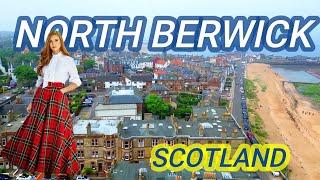
North Berwick Scotland walking video #gimbalwalkwithme
North Berwick is a seaside town and former royal burgh in East Lothian, Scotland. It is situated on the south shore of the Firth of Forth, approximately 20 miles (32 km) east-northeast of Edinburgh. North Berwick became a fashionable holiday resort in the nineteenth century because of its two sandy bays, the East (or Milsey) Bay and the West Bay, and continues to attract holidaymakers. Golf courses at the ends of each bay are open to visitors.
The name Berwick means "barley farmstead" (bere in Old English means "barley" and wic means "farmstead"). Alternatively, like other place names in Scotland ending in 'wick', this word means 'bay' (Old Norse: vík). The word North was applied to distinguish this Berwick from Berwick-upon-Tweed, which throughout the Middle Ages the Scots called South Berwick. It was recorded as Northberwyk in 1250.
Excavations have shown that from as early as the eighth century, a ferry crossing to Earlsferry, near Elie in Fife was in existence, serving pilgrims on their way to the shrine of Saint Andrew. North Berwick Harbour was built in the twelfth century to meet the demands made of the existing ferry trade. This ferry was recently reinstated; during the summer, a boat travels between North Berwick and Anstruther in Fife, in homage to the original ferry.
Around 1150, Duncan, Earl of Fife of the Clan MacDuff founded an influential Cistercian nunnery (whose power continued until the Scottish Reformation, and its dissolution in 1588). Duncan's family shortly afterwards, at the start of the thirteenth century built North Berwick Castleerecting a wooden motte and bailey on the site of what is now Castle Hill in the east end of the town, at the start of Tantallon Terrace. This castle was attacked and held by the Earl of Pembroke around 1306; the English abandoned it by 1314, during the aftermath of the Battle of Bannockburn. Late in the fourteenth century the Lauder family (owners of the Bass Rock castle) erected a stone tower with a barmkin on the site; however they had abandoned it by 1420 in favour of the Bass, possibly as a result of conflict with the owners of nearby Tantallon Castle.
In the fourteenth century the town became a baronial burgh under William Douglas, 1st Earl of Douglas, who then built nearby Tantallon Castle to consolidate his power.
Despite the railway arriving in 1850, the Industrial Revolution bypassed the town. The late-nineteenth century saw North Berwick develop golfing and holiday facilities. The town soon became popular as a home for Edinburgh commuters and retirees.
The size and population of the town remained fairly steady until the 1970s, at which point housebuilding began in earnest around the periphery of the town, first to the south (1950s–70s), then in a series of major expansions to the west (1980s-present) along the line of the railway. There is talk of further developments focussing on "affordable housing", on the south side of the town. While the population has grown significantly but not truly "exploded", house prices have rocketed since the 1950s. North Berwick consistently appears at the top of national house price surveys, and like-for-like prices are comparable to Edinburgh. North Berwick was listed as the most expensive seaside town in Scotland in 2006, and was second to St. Andrews in 2009. In 2021, it was voted best place to live in Scotland
► LIKE AND SUBSCRIBE!
Subscribe to our channel here 👉🏻 https://www.youtube.com/channel/UCyXs...
► Gimbal Come with me on social media
Facebook group 👉🏻 https://www.facebook.com/groups/78364...
Twitter 👉🏻 https://twitter.com/Jarosla12154508
Instagram 👉🏻 https://www.instagram.com/moje_podroz...
Youtube 👉🏻 https://www.youtube.com/channel/UCyXs...
If you like this video, please click thumbs up and subscribe so you don't miss any more videos.
The film is my idea and production.
Unauthorized use is prohibited
The video is copyrighted and belongs to the Gimabal Walk With Me website
#GimbalWalkWithWe #gmibalwalktv #visituk
The name Berwick means "barley farmstead" (bere in Old English means "barley" and wic means "farmstead"). Alternatively, like other place names in Scotland ending in 'wick', this word means 'bay' (Old Norse: vík). The word North was applied to distinguish this Berwick from Berwick-upon-Tweed, which throughout the Middle Ages the Scots called South Berwick. It was recorded as Northberwyk in 1250.
Excavations have shown that from as early as the eighth century, a ferry crossing to Earlsferry, near Elie in Fife was in existence, serving pilgrims on their way to the shrine of Saint Andrew. North Berwick Harbour was built in the twelfth century to meet the demands made of the existing ferry trade. This ferry was recently reinstated; during the summer, a boat travels between North Berwick and Anstruther in Fife, in homage to the original ferry.
Around 1150, Duncan, Earl of Fife of the Clan MacDuff founded an influential Cistercian nunnery (whose power continued until the Scottish Reformation, and its dissolution in 1588). Duncan's family shortly afterwards, at the start of the thirteenth century built North Berwick Castleerecting a wooden motte and bailey on the site of what is now Castle Hill in the east end of the town, at the start of Tantallon Terrace. This castle was attacked and held by the Earl of Pembroke around 1306; the English abandoned it by 1314, during the aftermath of the Battle of Bannockburn. Late in the fourteenth century the Lauder family (owners of the Bass Rock castle) erected a stone tower with a barmkin on the site; however they had abandoned it by 1420 in favour of the Bass, possibly as a result of conflict with the owners of nearby Tantallon Castle.
In the fourteenth century the town became a baronial burgh under William Douglas, 1st Earl of Douglas, who then built nearby Tantallon Castle to consolidate his power.
Despite the railway arriving in 1850, the Industrial Revolution bypassed the town. The late-nineteenth century saw North Berwick develop golfing and holiday facilities. The town soon became popular as a home for Edinburgh commuters and retirees.
The size and population of the town remained fairly steady until the 1970s, at which point housebuilding began in earnest around the periphery of the town, first to the south (1950s–70s), then in a series of major expansions to the west (1980s-present) along the line of the railway. There is talk of further developments focussing on "affordable housing", on the south side of the town. While the population has grown significantly but not truly "exploded", house prices have rocketed since the 1950s. North Berwick consistently appears at the top of national house price surveys, and like-for-like prices are comparable to Edinburgh. North Berwick was listed as the most expensive seaside town in Scotland in 2006, and was second to St. Andrews in 2009. In 2021, it was voted best place to live in Scotland
► LIKE AND SUBSCRIBE!
Subscribe to our channel here 👉🏻 https://www.youtube.com/channel/UCyXs...
► Gimbal Come with me on social media
Facebook group 👉🏻 https://www.facebook.com/groups/78364...
Twitter 👉🏻 https://twitter.com/Jarosla12154508
Instagram 👉🏻 https://www.instagram.com/moje_podroz...
Youtube 👉🏻 https://www.youtube.com/channel/UCyXs...
If you like this video, please click thumbs up and subscribe so you don't miss any more videos.
The film is my idea and production.
Unauthorized use is prohibited
The video is copyrighted and belongs to the Gimabal Walk With Me website
#GimbalWalkWithWe #gmibalwalktv #visituk
Тэги:
#NORTH_BERWICK #BERWICK #SCOTLAND #north_berwick #north_berwick_beach #GIMBAL_WALK_WITH_MEКомментарии:
North Berwick Scotland walking video #gimbalwalkwithme
Gimbal Walk With Me
Многоженство в Дагестане
РГВК "Дагестан"
Do Not Open This Book by Andy Lee | Kids Book Read Aloud Story
Magical Little Minds - Read Along Storytime
Fally Ipupa - MH - Cover by Gloria Bash
Gloria Bash
funny breastfeeding baby part 2
Morrigan's mom Diary
Simulaciones veloces de Houdini con 200GB RAM
GridMarkets
留学欧洲?这三件事情要了解!
Sui Yi


























